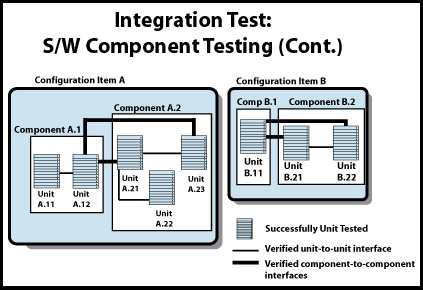

The project Software Test Plan describes the overall testing strategy for both the informal and formal software tests. This includes defining the required level and kind of testing to ensure the required level of confidence in the software. At the software integration testing level of testing, software elements are incrementally integrated to form continually larger and more complex software builds. The software integration testís purpose is to both identify errors and demonstrate interface compatibility. At the initial integration stage (Software Component Testing), software units are incrementally integrated to form components and components are integrated to form configuration items. At the second stage (Software Configuration Item Testing) integration continues until all software configuration items are integrated with the system level hardware suite into a single functioning software system.
Two approaches to integration testing are:
- Top-down testing starts with a high-level driver that ultimately evolves into the system exerciser; supports early definition of interfaces, early system level executions, and parallel testing at several levels.
- Bottom-up testing usually begins on individual modules (i.e., modules, sub-modules, database, global tables, etc.). In turn, these modules are integrated with other modules in a building block approach; individual drivers are combined, added to, or modified, until they become very complicated and usually cannot adequately test the entire system at one time; this allows early testing of critical or complex modules.
In practice, an approach is to use a combination of top-down and bottom-up testing. This minimizes risks by rigorously testing critical or complex software early and minimizes the development of test software by using high level drivers and previously tested system software to drive tests.
Configuration Item Testing is sometimes called Function Testing. Configuration item (CI) testing is the term for testing a major software entity that is developed and put through software configuration management as a single item. The purpose of this testing type is to identify errors and demonstrate the software functionality.
Integration Test.The purpose of the graphics Software Component Testing, Software Component to Component Testing and, Software Configuration Item Testing is to illustrate that there are three levels of integration that may need to be addressed: Component Testing; Component to Component Testing; Configuration Item to Configuration Item Testing. The three level names and acronyms are Configuration Software Unit (CSU) Configuration Software Component (CSC) and, Configuration Software Configuration Item (CSCI).
The similarities between all three of the Configuration Software (CS)ís are: groups of modules being tested; the checkout of interfaces and, the checkout of overall system logic. These may be conducted in the same stage, but should be done incrementally. A configuration item considered of as a "software build" or a software product. These figures help convey that components and configuration items are logical groupings of software.
CSU to CSU

Integration Test: S/W Component to Component Testing.
CSC to CSC
